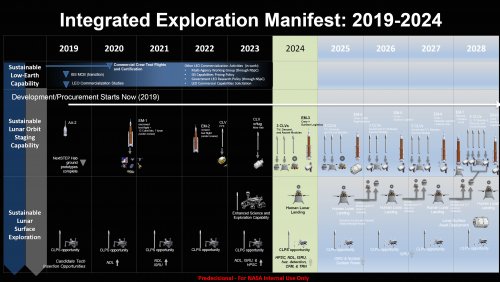- Joined
- 21 January 2015
- Messages
- 12,095
- Reaction score
- 16,228
Facing more delays, NASA opens door to launching lunar mission with commercial rockets
And from the other side.
COALITION FOR DEEP SPACE EXPLORATION STATEMENT FOLLOWING SENATE COMMERCE HEARING WITH THE NASA ADMINISTRATOR
This morning at a hearing of the Senate Commerce, Science, and Transportation Committee, NASA Administrator Bridenstine mentioned that NASA is investigating an alternate approach to flying an Orion crew vehicle and European Service Module (SM) to the Moon by June of 2020. This approach would continue the development of the Space Launch System (SLS), enabling a full testing regime for this critical national asset, and bring SLS and Orion together for the following mission.
No launch vehicle other than the SLS can enable the launch of a fully-outfitted Orion, including the SM, to the Moon. As a result, the Administrator noted that this approach would require at least two launches of heavy-lift vehicles. It could also include in-orbit assembly of a launch vehicle with an upper stage, which would then be used to direct Orion and the SM to the Moon. The analysis to determine whether this approach is feasible is still ongoing. The integration challenges are significant. It is also clear that this approach would require additional funding, since the idea is to undertake both this mission and to continue development of the SLS apace.
The assessment of options such as these are the hallmark of both NASA and the aerospace industry that supports it. Distributed across all 50 states in civil, commercial and military space, the aerospace and defense industry is crucial to U.S. competitiveness across the globe and to American leadership in science, security, entrepreneurship and human exploration of space. The Coalition for Deep Space Exploration and its member companies strongly support forward-leaning efforts to speed human return to the Moon. We welcome the opportunity to join NASA in the flights of Orion, SLS and the Exploration Ground Systems that support these journeys, and the rapid expansion of science, commerce and human exploration at the Moon and beyond.
In a major shift, NASA is considering using two commercial launchers to send an unpiloted Orion crew capsule and its European-built service module on a test flight around the moon next year, maintaining the lunar test flight’s schedule despite fresh delays in the development of the multibillion-dollar Space Launch System that jeopardize the heavy-lifter’s 2020 inaugural flight, the agency’s administrator said in a congressional hearing Wednesday.
And from the other side.
COALITION FOR DEEP SPACE EXPLORATION STATEMENT FOLLOWING SENATE COMMERCE HEARING WITH THE NASA ADMINISTRATOR
This morning at a hearing of the Senate Commerce, Science, and Transportation Committee, NASA Administrator Bridenstine mentioned that NASA is investigating an alternate approach to flying an Orion crew vehicle and European Service Module (SM) to the Moon by June of 2020. This approach would continue the development of the Space Launch System (SLS), enabling a full testing regime for this critical national asset, and bring SLS and Orion together for the following mission.
No launch vehicle other than the SLS can enable the launch of a fully-outfitted Orion, including the SM, to the Moon. As a result, the Administrator noted that this approach would require at least two launches of heavy-lift vehicles. It could also include in-orbit assembly of a launch vehicle with an upper stage, which would then be used to direct Orion and the SM to the Moon. The analysis to determine whether this approach is feasible is still ongoing. The integration challenges are significant. It is also clear that this approach would require additional funding, since the idea is to undertake both this mission and to continue development of the SLS apace.
The assessment of options such as these are the hallmark of both NASA and the aerospace industry that supports it. Distributed across all 50 states in civil, commercial and military space, the aerospace and defense industry is crucial to U.S. competitiveness across the globe and to American leadership in science, security, entrepreneurship and human exploration of space. The Coalition for Deep Space Exploration and its member companies strongly support forward-leaning efforts to speed human return to the Moon. We welcome the opportunity to join NASA in the flights of Orion, SLS and the Exploration Ground Systems that support these journeys, and the rapid expansion of science, commerce and human exploration at the Moon and beyond.












